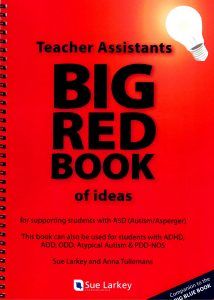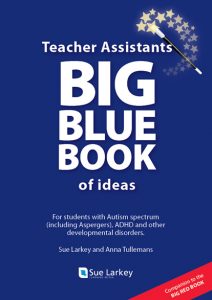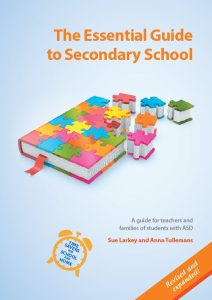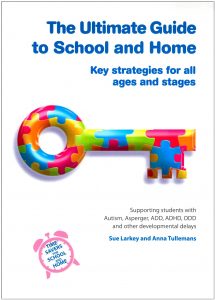Article by Anna Tullemans
When a student engages in inappropriate behaviour it’s important to understand the purpose of the behaviour. Refrain from getting into power struggles with the student. Personal and environmental challenges can have a big impact on student behaviour. The behaviour needs to be analysed to determine possible personal and environmental challenges contributing to the behaviour.

1. Determine the Appropriate Behaviour
- What behaviours are absolutely essential for the student’s safety and for the safety of others (eg. stay within boundaries, walk beside someone, hold someone’s hand.)?
- What behaviours are essential to the well being of others (eg. use words or gestures other than yelling, kicking)?
- What behaviours are needed to be successful with peers (eg. attend to things that other students attend to, be aware of others, play with others)?
- What behaviours are needed to take part in school activities?
- What behaviours will keep the student learning (eg. attend to certain activities, work independently)?
- What behaviours will build self esteem in the student (eg, help the teacher, play with others, and get all the work right)?
2. Analyse the Purpose of the Inappropriate Behaviour
Try to figure out what the behaviour means from the students point of view. Ask questions related to risk and protective factors of the student.
- Is the student missing information that would enable him to perform better?
- Has this behaviour been taught in a concrete, sequential manner?
- Has the student practiced the appropriate behaviour with success in this environment?
- Has the behaviour been practiced in a variety of settings?
- What are other students doing when this behaviour occurs?
Sometimes the answer lies between the students’ challenges and the environmental challenges. Remember to use the ABC approach.
Antecedent – What happened before the behaviour?
Behaviour – What is the behaviour that is being exhibited?
Consequence – What happens after the behaviour?
Remember that behaviours are also a form of communication. These behaviours might be telling you something that the student cannot tell you himself.
3. Teach the Appropriate Replacement Behaviour
To stop inappropriate behaviour you must also teach the replacement behaviour to the student. You must also teach self monitoring strategies and help to diffuse any situations so that learning may take place.
Specific Behaviours of Concern
There are three specific behaviours that are usually of concern in a learning environment: aggression, non-compliance, and tantrums. We must understand the reasons and purpose for these behaviours and use the appropriate strategies for each particular student.
Aggression (Hitting, Kicking, Biting, Shoving)
Sometimes students use various methods in an attempt to make people understand their wants and needs. Usually aggression is a last resort. We must analyse the aggressive behaviour of the student and find the meaning behind that behaviour. Ask these questions:
- Why did the student use this behaviour?
- What is the message the student is trying to convey?
- Why did the student use this behaviour to convey the message?
The critical questions to ask are:
- What primary challenges for this student hinder development of more appropriate means to have his messages understood?
- Does the student have sensory problems that are beyond tolerance levels?
- Does the student need to finish something and become upset if interrupted?
- Does the student have the means to communicate wants and needs so everyone understands?
- Do the people in this environment respond to the appropriate means of communication when used?
- Are positive interactions patterns established between the student and peers?
- Are there activities that the student can do with others?
- Are lots of negative messages delivered to this student?
- Can the student defend himself?
- Are there clear expectations and are they applied consistently?
Then you need to ask: What behaviour does the student need to learn to replace the inappropriate behaviour?
Does he need to learn to:
- Ask someone to stop or move
- Ask someone for help
- Tell someone “no”
- Learn what activities and rules are negotiable and which are not
- Learn to wait
- Learn to take turns
- Learn when some things are not possible
- To accept changes
- Accept the answers of others
- Tell someone he doesn’t feel well

Then we need to devise a plan to teach new behaviours by:
- Deciding on exact words and cues that will be used to teach the student
- Provide multiple opportunities to model the new behaviour
- Respond and react positively to the new behaviour
Finally develop a plan for what to do when the behaviour occurs:
- Set a plan that everyone can use when the behaviour occurs
- Avoid giving the behaviour too much attention
- Show what behaviour is appropriate
Non-compliance
Noncompliance is defined as when students do something they know they should not do or refuse to do something that someone wants them to do. It can be difficult and annoying. To understand the noncompliance behaviour and determine the appropriate replacement behaviour you need to ask: what is the purpose of the behaviour from the student’s point of view?
- Does the student know the rules, or do the rules keep changing depending on the person and the situation? Is there really consistency?
- Can the student do what is being asked? What would help the student comply?
- Is the student using this behaviour to interact?
- Does the student have choice and control over parts of the day at school?
- Is the student reinforced for following rules and doing something some one wants him to do?
- Does behaving appropriately earn attention meaningful rewards, or is behaving just expected and thus overlooked?
- Are sensory issues involved?
- Does the student know what is going to happen next and feel comfortable about it?
Our next step is to ask ourselves: What puts the student at risk for not being able to learn appropriate behaviours? Is it:
- Not understanding interactions and being successful with them
- Not being able to communicate wants and needs well
- Not being listened to and understood
- A small repertoire of activities and interests
- Sensory issues
- Learning and attention problems
- Anxiety and fears?
Then you need to ask: what does the student need so as not to engage in this behaviour?
Is it to learn to:
- Get more attention in a more direct way
- And practice the rules in a consistent way
- To communicate wants and needs directly – to have choices
- Have more interesting things to do
- To wait
- To follow a visual sequence and predict what is coming next
- Have more activities and interests to be redirected or directed to?
Finally develop a plan for what to do when the student engages in the behaviours.
Follow a plan with well established procedures. When there is non-compliance then everyone can follow the same plan and there is consistency for the student. Make sure the student knows the rule by practicing. However don’t practice when the student is heading for meltdown.
Tantrums/Meltdowns
Tantrums can disrupt the flow of learning for all concerned. Tantrums, like other behaviours, are messages from students. They need to be analysed by asking typical questions.
What does the behaviour mean from the students point of view
- Why is the student refusing
- Is he afraid, overwhelmed, or overstimulated
- Is the pace too fast or too slow for the student
- Are there too many demands
- Are there sensory issues
- Is the student tired or sick
- What are the necessary skills the student is lacking to cope with the situation does the student have more appropriate means to refuse, and are these behaviours “allowed” and responded to? ie is the student responding to refusal?
- What does the student need to learn ie a more appropriate way to refuse
- Will an appropriate way to refuse be acknowledged and honoured
Finally consider how to make refused activities more acceptable and motivating:
- Which activities are choice and which are not? Is this very clear?
- Can the student make choices? Are there opportunities for choice?
- What is the value or motivation to comply?
- Are there too many rules?
- Are the rules clear and appropriate?
Conclusion
Remember that each student is unique and that each student will have individual challenges. This uniqueness requires people to accept some behaviours which may seem odd at times. The student may have unique ways in which to calm down and keep anxiety levels in check, and the student may engage in these behaviours without regard to who is around or the location.
This requires us to teach the student where to engage in these behaviours, how to not be so conspicuous while engaging in these behaviours or a more acceptable behaviour to accomplish the same purpose.
We must accept and acknowledge that there is a need for this behaviour.
As a team, parents, educators and peers can broaden the student’s world and people’s understanding of ASD.

